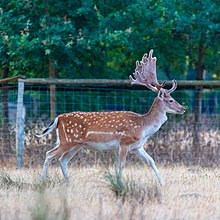Loading AI tools
Genus of deer commonly called "fallow deer" From Wikipedia, the free encyclopedia
Fallow deer is the common name for species of deer in the genus Dama of subfamily Cervinae.[3]
| Fallow deer Temporal range: | |
|---|---|
 | |
| European fallow deer (D. dama) | |
| Scientific classification | |
| Domain: | Eukaryota |
| Kingdom: | Animalia |
| Phylum: | Chordata |
| Class: | Mammalia |
| Order: | Artiodactyla |
| Family: | Cervidae |
| Tribe: | Cervini |
| Genus: | Dama Frisch, 1775 |
| Type species | |
| Cervus dama [1] Linnaeus, 1758 | |
| Living Species | |
|
For extinct species, see text | |
| Synonyms[2] | |
| |
The name fallow is derived from the deer's pale brown colour. The Latin word dāma or damma, used for roe deer, gazelles, and antelopes, lies at the root of the modern scientific name, as well as the German Damhirsch, French daim, Dutch damhert, and Italian daino. In Serbo-Croatian, the name for the fallow deer is jelen lopatar ("shovel deer"), due to the form of its antlers. The Modern Hebrew name of the fallow deer is yachmur (יחמור).
The genus includes two extant species:
| Common name | Scientific name and subspecies | Range | Size and ecology | IUCN status and estimated population |
|---|---|---|---|---|
| European fallow deer | Dama dama (Linnaeus, 1758) |
Confirmed native only to Turkey, but possibly native to the Italian Peninsula, the Balkans, and the island of Rhodes in Greece; introduced from Roman times onwards to the rest of Europe, and around the world in more recent times |
Size: Habitat: Diet: |
LC
|
| Persian fallow deer | Dama mesopotamica (Brooke, 1875) |
Iran and Israel; once ranged throughout the Middle East and eastern Turkey |
Size: Habitat: Diet: |
EN
|
Some taxonomists classify the Persian fallow deer as a subspecies (D. d. mesopotamica),[1] while others, such as the IUCN, treat it as a separate species (D. mesopotamica).[4] Based on genetic evidence, Dama is considered to be closest living relative of the extinct genus Megaloceros.[5] The circumscription of the genus is uncertain, with some authors choosing to include taxa that are otherwise placed in the genus Pseudodama, which may be ancestral to Dama.[6]
The earliest species of Dama appeared around the Pliocene-Pleistocene boundary approximately 2.6 million years ago,[7] or around the beginning of the Middle Pleistocene approximately 0.8 million years ago,[8] depending on the species included in the genus. The relationships of most Dama species to each other and to other fossil deer are controversial, with no overall consensus on their relationships, aside the close relationship of D. clactoniana with the living Dama species. The earliest Dama species lack palmate (broad and flattened) antlers, with this trait only developing in D. pelleponesica, D. clactoniana, and the two living species.[6]
Extinct species, based on van der Made et al. 2023:[6]
Relationships of Dama to other deer species based on mitochondrial DNA.[11]
| Cervidae |
| |||||||||||||||||||||||||||||||||||||||||||||||||||||||||||||||||||||||||||||||||||||||
Seamless Wikipedia browsing. On steroids.
Every time you click a link to Wikipedia, Wiktionary or Wikiquote in your browser's search results, it will show the modern Wikiwand interface.
Wikiwand extension is a five stars, simple, with minimum permission required to keep your browsing private, safe and transparent.